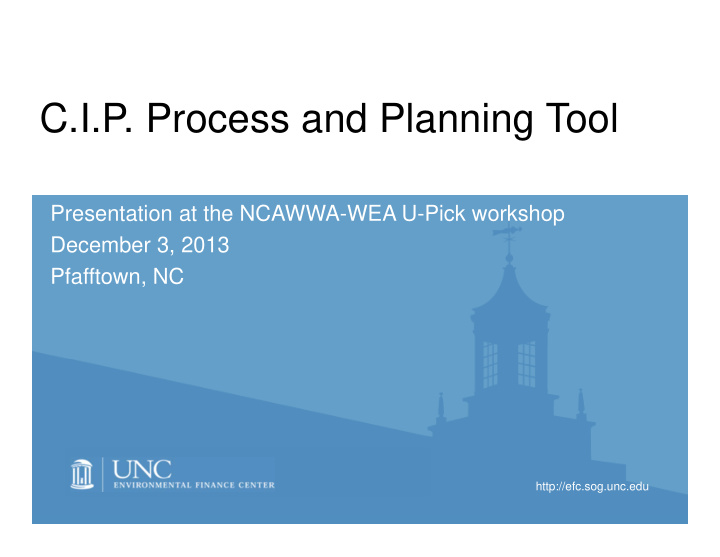



C.I.P. Process and Planning Tool Presentation at the NCAWWA-WEA U-Pick workshop December 3, 2013 Pfafftown, NC http://efc.sog.unc.edu
Housed at the UNC School of Government. Dedicated to enhancing the ability of governments and other organizations to provide environmental programs and services in fair, effective and financially sustainable ways.
User-Friendly C.I.P. Tool for Water & Wastewater Utilities Free, simplified CIP tool using only MS Excel, developed by the Environmental Finance Center at UNC Tool development was funded by the Public Water Supply Section of DWR/ NCDENR and partly by the USEPA
Download the latest version at http://efc.sog.unc.edu Go to Resources / Tools, then scroll to find it For more resources on capital planning, at the EFC website: Go to Programs / Drinking Water & Wastewater / Capital Planning Resources for Water & Wastewater Utilities
How Quickly are Costs Related to Capital Rising? Annual Changes to CPI ‐ U ("Inflation") and • Instead of Construction Cost Index: 1984 ‐ 2012 9% looking at Inflation (Annual Change in the CPI ‐ U) 8% Annual Change in the Construction Cost Index Consumer Price 7% 6% Index, look at 5% Construction %/year 4% Cost Index 3% (CCI). 2% 1% • ~3%/year. 0% 1984 1985 1986 1987 1988 1989 1990 1991 1992 1993 1994 1995 1996 1997 1998 1999 2000 2001 2002 2003 2004 2005 2006 2007 2008 2009 2010 2011 2012 ‐ 1% Data Sources: Bureau of Labor Statistics, Engineering News-Record ENR.com, InflationData.com, USDA Natural Resources Conservation Services http://efc.web.unc.edu/2012/09/26/using-an-index- to-help-project-capital-costs-into-the-future/
Smart Management for Small Water Systems under a Cooperative Agreement with the US EPA • Do you work for or with a water system? • Do you serve 10,000 people or fewer? Thanks to EPA, the EFC Network can provide free direct one-on-one assistance on any of the following topics: – Asset Management – Fiscal Planning and Rate Setting – Water Loss Reduction – Water System Collaboration – Energy Management – Funding We can review or help you complete your own C.I.P. spreadsheet. Sign up for direct assistance at http://efcnetwork.org/one-on-one/
Acknowledgement Public Water Supply Section (Division of Water Resources, NC DENR) 7
Shadi Eskaf eskaf@sog.unc.edu 919-962-2785 Environmental Finance Center at the University of North Carolina School of Government, Knapp-Sanders Building CB #3330 Chapel Hill, NC 27599-3330 USA http://efc.sog.unc.edu
Recommend
More recommend